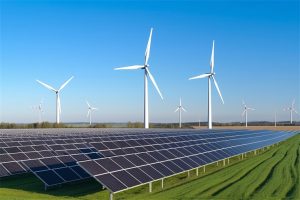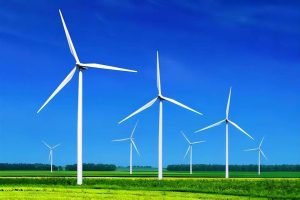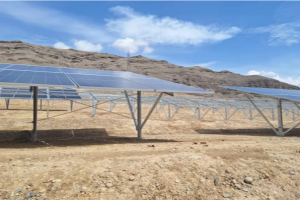Le changement mondial vers l'énergie propre s'est considérablement accéléré ces dernières années alors que les nations s'efforcent de lutter contre le changement climatique et de réduire les émissions de gaz à effet de serre. Par 2025, L'industrie de l'énergie propre devrait atteindre de nouveaux sommets, tiré par les progrès technologiques, changements de politique, et une demande croissante de sources d'énergie durables. This forecast will explore the key factors shaping the clean energy landscape, focusing on developments in renewable energy technologies, market dynamics, policy support, and the challenges that may arise along the way.

Key Forecast Trends for the Clean Energy Industry in 2025
Growth in Solar and Wind Power Capacity
Solar and wind energy have already established themselves as the leading renewable energy sources globally, and their growth is expected to continue in 2025. Selon l'Agence internationale de l'énergie (Iea), solar PV capacity is anticipated to surpass 1,500 gigawatts (GW) par 2025, nearly doubling from current levels. The declining cost of solar panel manufacturing, advancements in efficiency, and widespread adoption of rooftop solar systems are key drivers of this growth.
Wind energy, both onshore and offshore, is also set to expand significantly. Offshore wind, in particular, is becoming more viable due to technological innovations such as floating turbines, which allow for installations in deeper waters. The global offshore wind capacity is expected to reach 234 GW by 2025, up from 50 GW in 2021. This expansion is supported by large-scale projects in Europe, the U.S., and China, where governments are making massive investments in clean energy infrastructure.
Energy Storage Solutions and Grid Integration
One of the main challenges of renewable energy is intermittency, which refers to the inconsistency of power generation from solar and wind sources. Energy storage systems, particularly lithium-ion batteries, are becoming essential for balancing supply and demand. Dans 2025, battery storage is forecasted to grow rapidly, with a market size exceeding $19 billion globally. The advancements in energy storage technologies, including longer-lasting and more efficient batteries, will improve grid stability and facilitate higher integration of renewables.
Beyond storage, smart grid technologies are expected to play a crucial role in managing distributed energy resources and integrating clean energy into the existing power infrastructure. Smart grids use advanced data analytics, intelligence artificielle (IA), and real-time monitoring to optimize energy distribution, reduce outages, and lower operational costs.

Expansion of Green Hydrogen Production
Hydrogène vert, produced using renewable energy through electrolysis, is emerging as a key player in the clean energy mix. It is viewed as a solution to decarbonize hard-to-electrify sectors such as heavy industry, transport, and heating. Par 2025, the global production of green hydrogen is projected to grow significantly, with investments expected to reach over $70 milliard.
Countries such as Germany, Japon, and Australia are leading the way in developing green hydrogen projects, driven by strong government support and corporate commitments to achieving net-zero emissions. en outre, many companies are exploring green hydrogen as a means to store excess énergie renouvelable, further enhancing its appeal as a future energy carrier.
Electric Vehicles (Véhicules électriques) and Clean Mobility
The transition to electric vehicles is poised to accelerate by 2025, driven by policy initiatives, advancements in battery technology, and increasing consumer demand. BloombergNEF predicts that EV sales will make up 20% of all new car sales by 2025, up from just 4% dans 2020. The adoption of EVs will significantly impact electricity demand, requiring further investment in charging infrastructure and clean power generation to support the growing fleet of electric cars.
Governments worldwide are implementing strict emissions regulations and offering incentives for EV purchases, which are driving the clean mobility shift. Automakers are also stepping up their production of EV models, with many committing to phase out internal combustion engine (GLACE) vehicles entirely in the coming decade. This shift is expected to boost demand for renewable electricity and energy storage, particularly during peak charging times.
Policy Support and Global Cooperation
The success of the clean energy industry in 2025 will largely depend on the continuation of strong policy support at both the national and international levels. Governments worldwide are implementing policies and regulations to promote renewable energy adoption, reduce carbon emissions, et support energy efficiency. En particulier, the U.S., the European Union, and China are expected to remain key players in advancing clean energy initiatives.
The Biden Administration’s commitment to achieving 100% clean electricity by 2035 has already spurred significant investment in renewable energy projects, with a focus on solar, vent, and battery storage. Similarly, the European Union’s Green Deal aims to make the EU climate-neutral by 2050, with ambitious renewable energy targets for 2030 et au-delà.
International cooperation will also play a crucial role in advancing the clean energy transition. Global initiatives like the Paris Agreement continue to drive collaborative efforts, while organizations such as the International Renewable Energy Agency (IRENA) and the IEA are working to promote best practices and support clean energy policies.

Decarbonization of Heavy Industry
Industries such as steel, ciment, and chemicals are among the most carbon-intensive sectors. Decarbonizing these industries is essential to achieving global climate goals, and by 2025, we expect to see further progress in this area. Solutions like green hydrogen, electrification, and carbon capture, utilization, and storage (CCUS) are gaining traction as viable options for reducing emissions in these industries.
Governments and corporations alike are investing in pilot projects to test the feasibility of these technologies at scale. Par exemple, green steel production using hydrogen as a reducing agent is being explored in Europe, while several CCUS projects are underway in North America and the Middle East.
Challenges Facing the Clean Energy Industry in 2025
Supply Chain Bottlenecks
The clean energy industry relies heavily on critical raw materials such as lithium, cobalt, and rare earth elements for battery manufacturing, panneaux solaires, and wind turbines. Supply chain disruptions, tensions géopolitiques, and resource shortages could pose significant challenges to the industry’s growth in 2025.
To mitigate these risks, companies and governments are exploring recycling programs, alternative materials, and domestic mining opportunities. toutefois, ensuring a stable and sustainable supply of these materials remains a concern for the global clean energy market.
Financing the Energy Transition
The energy transition requires substantial capital investment, particularly in developing countries where energy access is still limited. Par 2025, the total investment needed to achieve clean energy targets is estimated to exceed $4 trillion annually. Securing this financing, especially in the face of economic uncertainties, is a key challenge for governments, entreprise, and investors.
Innovative financing mechanisms, such as green bonds and public-private partnerships, are helping to close the gap, but more efforts are needed to ensure that clean energy projects receive the funding necessary for large-scale deployment.

Grid Stability and Resilience
As more renewable energy sources come online, ensuring the stability and resilience of power grids will become increasingly important. The intermittent nature of solar and wind energy poses challenges to grid operators, who must balance variable supply with fluctuating demand. Advanced grid management systems, energy storage, and demand response solutions are essential for addressing these challenges.
En plus, climate change itself presents a threat to energy infrastructure, with extreme weather events such as hurricanes, floods, and heatwaves becoming more frequent. Enhancing the resilience of power grids to withstand these events is a growing priority for the energy sector.
Conclusion
The clean energy industry is on the brink of a major transformation, with 2025 marking a pivotal year in the global energy transition. The rapid growth of renewable energy sources, the rise of electric vehicles, advancements in energy storage, and the emergence of green hydrogen are all driving this change. toutefois, challenges such as supply chain disruptions, financing gaps, and grid stability must be addressed to ensure the industry’s continued success.
By focusing on innovation, policy support, and international cooperation, the clean energy sector can achieve its ambitious targets for 2025 et au-delà, paving the way for a more sustainable and resilient energy future.



